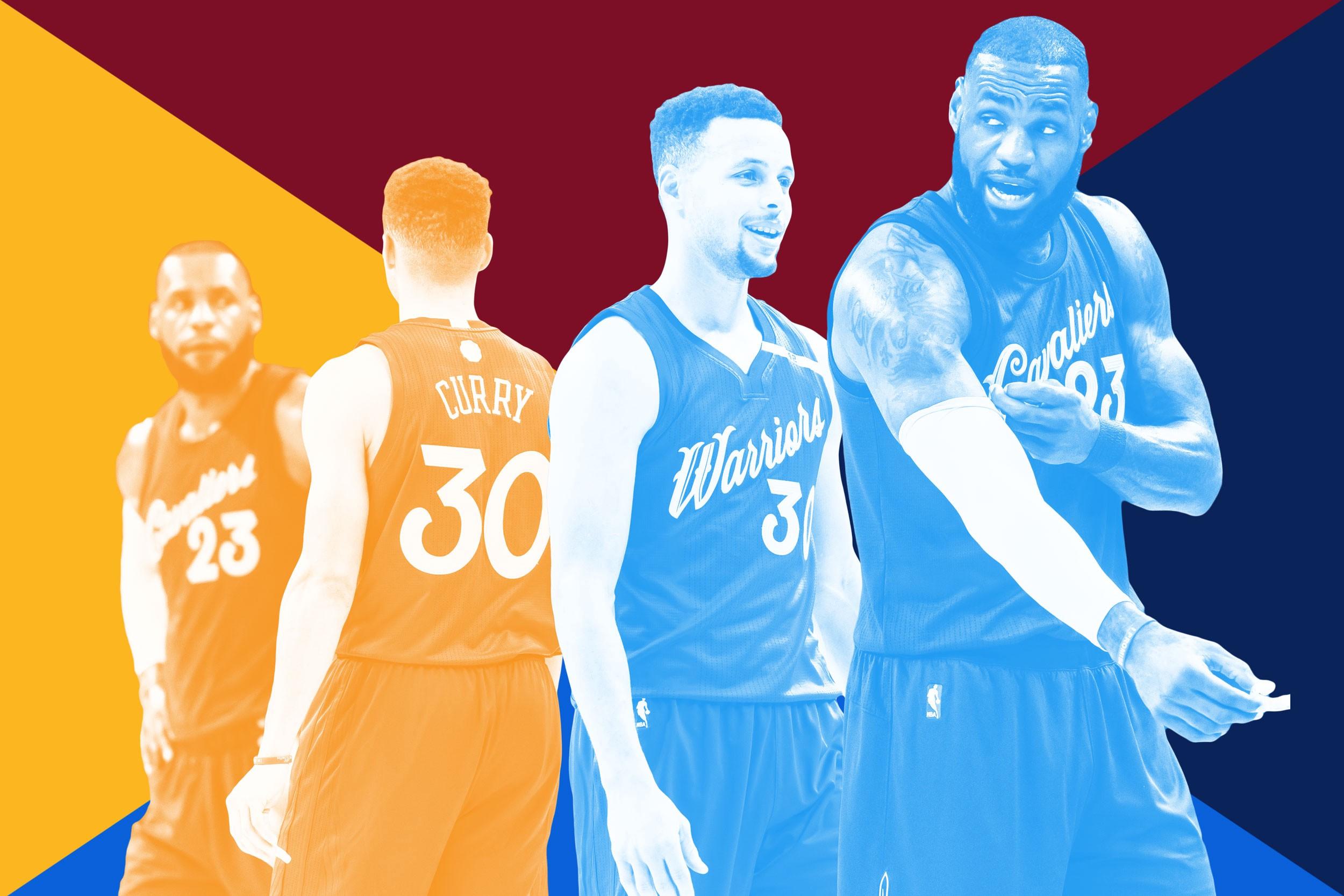
Cavs vs. Warriors III is finally here. Ever since Kevin Durant signed with Golden State, we have wondered how his presence would impact its almost inevitable matchup with Cleveland in the NBA Finals. While there were many fun story lines and great individual performances in the regular season, there was never any real doubt about who would be left standing in the end. The Warriors and Cavs are playing at a higher level than every other team in the league, and they’ve combined to go 24–1 in this season’s playoffs. There hasn’t been much drama or excitement in their path to get to this point, but all will be forgiven if we get anything close to what happened in last year’s Finals.
The teams split their two regular-season meetings this season, with the Cavs winning a 109–108 classic on Christmas Day and the Warriors getting their revenge in a 126–91 drubbing on Martin Luther King Jr. Day. J.R. Smith, the only notable absence from either team in those games, is back in the Cleveland lineup after missing most of the regular season with a thumb injury. The Cavs have also added two key veterans to their rotation since the Christmas Day game, trading for Kyle Korver and picking up Deron Williams on the buyout market. Warriors coach Steve Kerr, meanwhile, has missed essentially the entire postseason with a back injury, and has been replaced by former Cleveland coach Mike Brown on an interim basis.
All that turnover means that what happened in December and January can tell us only so much about the state of each team in June. However, there are some interesting takeaways from those games about the way the Cavs and Warriors match up with each other. The coaching staffs for each team have reviewed the film enough times to reel off specific plays from those games in their sleep, and they both have a long list of adjustments in their back pocket as a result. Here’s a look at the key story lines from the first two meetings between these teams and how they could play out over the next few weeks.
Who Guards Whom in the Backcourt?
In the Christmas Day game, Kyrie Irving started on Klay Thompson while DeAndre Liggins, who is no longer on the Cavs roster, started on Steph Curry. By the time the rematch happened, Liggins had been replaced in the starting lineup by Iman Shumpert, who started on Kevin Durant, creating a domino effect with Kyrie staying on Curry and LeBron James guarding Thompson. The Warriors’ initial defensive assignments were the same in both games, with Thompson on Irving, Durant on James, and Curry hiding on Cleveland’s shooting guards.
Thompson is one of the better defensive guards in the NBA, but Kyrie had little trouble dissecting him off the dribble and getting into the lane. The Cavs’ star point guard exploded for 14 points in the fourth quarter on Christmas Day, including a winding fadeaway to win the game in the final seconds.
For all the points Kyrie scored on Klay, though, he gave away just as many on defense. Thompson’s size allowed him to shoot over Kyrie, but the real damage came when he cut to the rim and curled off screens. Cleveland played terrible off-ball defense in both games, and Kyrie was one of the main culprits, repeatedly losing his man and failing to communicate on switches. The Warriors love to use their star guards to set back screens and slip to the basket, and the Cavs cannot afford to give them free points in the half court. Watch Irving fall asleep on this play and give Thompson a wide-open corner 3:
Cleveland will have a much more difficult challenge defensively in this year’s Finals, not only due to Durant, but because Curry is playing at 100 percent. He is having the best postseason of his career, averaging 28.6 points per game on 50.2 percent shooting, a far cry from the hobbled version of himself who averaged 22.6 points per game on 40.3 percent shooting in last year’s Finals. The Cavs, like the rest of the league, don’t have a great matchup for him defensively, so he should be able to kill whoever is guarding him, especially now that the Warriors have figured out how to keep him and Durant involved in the offense. Curry had 15 points and three assists on Christmas Day and 20 points and 11 assists in the rematch; the Cavs need to keep his production closer to the former to pull off the upset for the second consecutive year.
Slowing Curry down starts with making him work on defense, which is where Smith could help. He is averaging only 6.6 points and 0.8 assists a game in the playoffs, but he should force Curry to stay attached to him on the perimeter and chase him around screens. Curry was essentially playing as a free safety in the regular season, and the only time he was challenged defensively was when the Cavs used his man to set ball screens. However, because he was usually guarding Shumpert or Liggins, the Warriors either doubled or hedged the ball handler in those situations, living with either of them as the primary decision-maker in four-on-three situations. Smith, who is shooting 44.9 percent from 3 on 3.8 attempts per game in the playoffs, is a much better shooter than both, and he could force Golden State into some tough defensive decisions.
On defense, Smith will probably spend time on all three of the Warriors’ perimeter stars. Cleveland will want Irving on Andre Iguodala or Ian Clark whenever possible, while LeBron will guard Draymond Green some in order to switch screens and stifle the Warriors’ pick-and-rolls. The better Smith can play on defense, the more energy LeBron will have for offense and the less time the Cavs will need to have a defensive specialist like Shumpert on the floor.
How Much Time Does LeBron Spend on Durant and Vice Versa?
Durant is taking the place of Harrison Barnes from last year’s Finals, whom the Cavs had essentially stopped guarding. Barnes was shook by the end of series, shooting 5-of-32 in the final three games, with many of those attempts coming on wide-open looks. The Cavs will need a different defensive strategy this time around, one that will require a lot more from LeBron. In the 2016 Finals, James became the first player in NBA history to lead both teams in points, rebounds, assists, steals, and blocks, and he’s going to have to play even better this year.
LeBron didn’t guard Durant much in the two regular-season games, and the Warriors star averaged 28.5 points a game on 51.3 percent shooting. He will have a big edge whenever LeBron’s not guarding him, since Shumpert, Smith, and Richard Jefferson don’t have the size to even contest his shot. The Warriors will run a lot of offense through Durant to force LeBron to guard him, and maybe even get him in foul trouble when he does. The more actions LeBron has to defend, the more likely it is he’ll pick up some cheap fouls:
Durant could be even more important defensively by easing some of the burden on Iguodala, who spent most of the past two Finals guarding LeBron. Iguodala won Finals MVP in 2015, but a back injury turned him into a shell of himself by the end of last year’s Finals, allowing LeBron to rampage unchecked through the Warriors defense. The more Durant guards LeBron, the more flexibility the Warriors will have on defense. Iguodala has the best combination of length, athleticism, and defensive IQ among their perimeter players, and he’s their best option for slowing down Kyrie if he starts to go off.
What Do the Cavs Get Out of Kevin Love?
No player had a wider swing in production between the two regular-season games than Love. After getting 20 points, six rebounds, and three assists on Christmas, Love played only 16 minutes on Martin Luther King Jr. Day before leaving with lower-back soreness. Everyone remembers Love stopping Steph in the final seconds of Game 7, but he had an uneven series before that, averaging only 8.5 points a game on 36.2 percent shooting. The Cavs need more production from Love to help balance out the extra offense the Warriors will get from Durant and a healthy Curry.
The good news for Cleveland is that Love looks as comfortable as he has ever been since joining the team. He made his first All-Star team with the Cavs this season and is averaging a career-high 17.2 points on 45.7 percent shooting in the playoffs, while shooting 47.5 percent from 3 on 6.2 attempts per game. He struggled to score in the post against either Draymond or Durant in the regular season, so coach Tyronn Lue’s best bet to feature him might be to run him off screens, involve him in pick-and-rolls to create a mismatch against smaller players on the interior, and unleash him on the offensive boards.
How Long Do the Warriors Keep Their Big Men In?
The biggest weakness in Golden State’s lineup is at center, where the team’s gone with a three-man platoon upfront (Zaza Pachulia, David West, and JaVale McGee) to replace Andrew Bogut’s production from last year. The biggest impact Zaza has made in the playoffs was injuring Kawhi Leonard, and the Cavs will test him on offense and defense whenever he is in the game. They ignored him in the regular season, hiding Love on him on defense and trapping the ball handler whenever Zaza set a screen in order to force the ball into his hands. If he can’t be a threat on offense, the Warriors will have to take him out of the lineup:
The big defensive adjustment Golden State made in the second game was having its centers switch screens and guard the Cavs ball handlers without extra help. The Warriors lived with LeBron going one-on-one, and he settled for contested jumpers rather than attacking the rim. The problem with that strategy is that LeBron is shooting a career playoff high from 3 (42.1 percent on 5.8 attempts per game), and none of Golden State’s centers has a prayer of guarding him if they extend out on defense. West and Pachulia aren’t quick enough to stay in front of LeBron, while JaVale is rarely sound enough positionally to be much of a threat.
Kerr’s decision to stay big in Game 7 of last year’s Finals may have cost the Warriors the championship, and Golden State fans will go to their graves wondering why Kerr stuck with Festus Ezeli (minus-9 in 11 minutes) and Anderson Varejão (minus-9 in eight minutes) for as long as he did. Brown will have a tough choice to make this time around, because while his centers are the weakest spot in his rotation, their size is also important to prevent Love and Tristan Thompson from making a killing on the offensive boards.
What Do the Cavs Do Against the New and Improved Lineup of Death?
Cleveland performed surprisingly well against Golden State’s killer lineups in the regular season; the Cavs outscored the Warriors by two points in the eight minutes that featured Golden State’s four All-Stars and either Iguodala or Shaun Livingston in the fifth spot. Those small-ball units didn’t even see the floor in the second regular-season game, with Kerr sticking with his centers throughout. The key for the Cavs was pounding the Warriors on the boards when they went small, with Tristan Thompson in particular being almost impossible to block out:
Cleveland kept Love on either Iguodala or Livingston, essentially leaving them wide open outside of the paint. Livingston doesn’t shoot 3s and Iguodala is 3-of-27 from beyond the arc in the playoffs, so expect the Cavs to try a similar tactic in the Finals. If those two can attack the open space they are given, force the Cleveland defense to respond to them, and create shots for their teammates, good things will happen:
Finding the Weak Points: Who Gets Attacked on Defense, and Who Gets Ignored on Offense?
Expect to see every variation of the 1–3 pick-and-roll in this series, with Durant setting picks for Curry, Curry setting picks for Durant, LeBron setting picks for Kyrie, and Kyrie setting picks for LeBron. The Cavs will be attacking Curry at every opportunity, while the Warriors will be doing the same to Kyrie. They are both undersized point guards who are relatively unathletic in comparison with Durant and LeBron, respectively, and neither will be able to survive long on an island against two of the best scorers in NBA history.
What both teams will likely do is send help, either by trapping the ball handler and rotating the other three defenders on the backside, or having Steph and Kyrie hedge out for a second and scramble back to their original man as fast as possible. There will be a constant back-and-forth in this series, because the players who can punish that strategy by knocking down open shots are also the ones most vulnerable to being attacked on defense. The dilemma is the same for both teams: The best shooters are their worst defenders, while their best defenders are their worst shooters. Each team has a designated perimeter threat (Korver for Cleveland, Clark for Golden State) who will struggle to guard in the pick-and-roll, and each team has a perimeter stopper (Shumpert for Cleveland, Iguodala for Golden State) who could struggle to knock down shots. If Korver or Clark can hold up on defense, or Shumpert or Iguodala can bury open 3s, it will change the dynamic for both teams.
Offensive Rebounds, Back Cuts, and the Possession Battle
The two team statistics that told the tale in the regular season were offensive rebounds for Cleveland and turnovers for Golden State:

According to the tracking numbers at Synergy Sports, the Warriors generated 12.3 percent of their offense through cuts this season, by far the highest percentage in the league. They love to play through Zaza and West in the post and then have their superstars set screens for each other, hoping to create easy baskets by catching the defense out of position. The downside of that strategy is that it results in a lot of high-risk passes being thrown through the lane, which the opposing defense can steal and turn into points the other way.
Controlling tempo will be huge for Cleveland. The Cavs need to get out in transition while preventing Golden State from doing the same by winning the battle on the offensive glass. Winning the possession battle will allow them to overcome some of the difference in talent. A lot of things have to go right for the Cavs to pull off the upset, and if the Warriors can take care of the ball and secure defensive rebounds, they should be able to come out on top.

